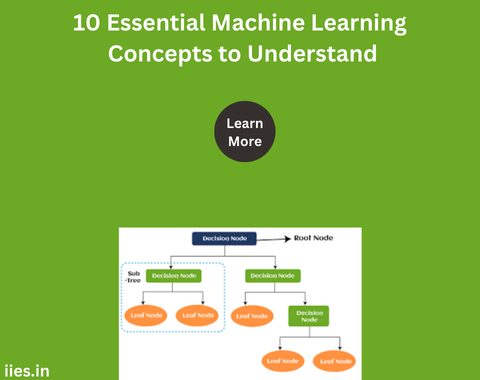
In an era where data is often touted as the new oil, machine learning stands out as the refinery, transforming raw information into actionable insights and powerful predictions. Whether it’s enabling personalized recommendations on streaming platforms, advancing diagnostic tools in medicine, or optimizing supply chains in logistics, the impact of machine learning is pervasive and profound. However, the journey to harnessing the full potential of machine learning begins with a solid understanding of its core principles and methodologies.
Machine learning (ML) has become a pivotal part of the technological landscape, driving innovations in various fields such as healthcare, finance, and entertainment. Understanding the fundamental concepts of machine learning is crucial for anyone looking to dive into this domain. Here are ten essential concepts to get you started.
Supervised learning is one of the most common types of machine learning. It involves training a model on a labeled dataset, meaning that each training example is paired with an output label. The model learns to predict the output from the input data. Common algorithms include linear regression, logistic regression, and support vector machines.
Unsupervised learning deals with unlabeled data. The goal is to find hidden patterns or intrinsic structures in the input data. Common techniques include clustering (e.g., k-means, hierarchical clustering) and association analysis (e.g., Apriori algorithm). Unsupervised learning is often used for exploratory data analysis.
Semi-supervised learning lies between supervised and unsupervised learning. It uses a small amount of labeled data and a large amount of unlabeled data. This approach can improve learning accuracy when acquiring a fully labeled dataset is expensive or time-consuming. Techniques like self-training and co-training are often used.
Reinforcement learning is a type of machine learning where an agent learns to make decisions by performing certain actions and receiving rewards or penalties. The goal is to maximize cumulative rewards over time. This concept is widely used in robotics, gaming, and autonomous vehicles. Key algorithms include Q-learning and deep Q-networks (DQNs).
Overfitting occurs when a model learns the noise in the training data rather than the actual underlying pattern. This results in poor generalization to new data. Underfitting, on the other hand, happens when a model is too simple to capture the underlying pattern of the data. Balancing these two is crucial for building robust models.
Feature engineering involves creating new features from raw data to improve the performance of machine learning models. This process includes selecting, modifying, and transforming variables. Good feature engineering can significantly boost the accuracy and efficiency of a model. Techniques include normalization, scaling, and polynomial features.
Evaluating and validating models is essential to ensure their reliability and performance. Common techniques include splitting the dataset into training, validation, and test sets, and using cross-validation. Metrics such as accuracy, precision, recall, F1-score, and area under the curve (AUC) are used to assess model performance.
The bias-variance tradeoff is a fundamental concept that addresses the tradeoff between the error introduced by the bias of a model and the variance of the model’s predictions. High bias can cause underfitting, while high variance can cause overfitting. The goal is to find a balance that minimizes the total error.
Dimensionality reduction techniques are used to reduce the number of features in a dataset while retaining important information. This can help improve model performance and reduce computational cost. Common techniques include Principal Component Analysis (PCA) and t-Distributed Stochastic Neighbor Embedding (t-SNE).
Neural networks are a set of algorithms, modeled loosely after the human brain, designed to recognize patterns. They are the foundation of deep learning. Deep learning involves neural networks with many layers (deep neural networks) and has led to breakthroughs in image recognition, natural language processing, and more. Concepts like backpropagation, activation functions, and convolutional layers are key components of neural networks.
Machine learning is a dynamic and rapidly evolving field, and understanding its essential concepts is fundamental for anyone looking to leverage its capabilities. By grasping the different learning paradigms—supervised, unsupervised, semi-supervised, and reinforcement learning—you can appreciate the diverse approaches to solving various problems. Recognizing the importance of balancing overfitting and underfitting ensures that your models generalize well to new data.
Indian Institute of Embedded Systems – IIES